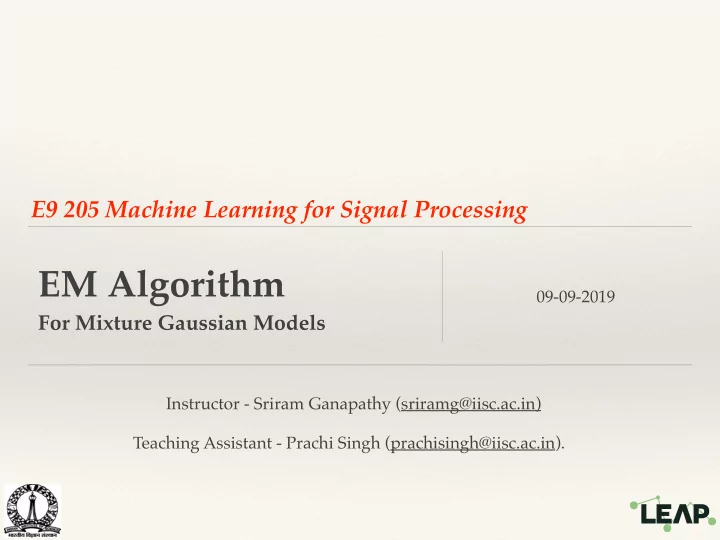

E9 205 Machine Learning for Signal Processing EM Algorithm 09-09-2019 For Mixture Gaussian Models Instructor - Sriram Ganapathy (sriramg@iisc.ac.in) Teaching Assistant - Prachi Singh (prachisingh@iisc.ac.in).
Basics of Information Theory • Entropy of distribution • KL divergence • Jensen’s inequality • Expectation Maximization Algorithm for MLE
Gaussian Mixture Models A Gaussian Mixture Model (GMM) is defined as The weighting coefficients have the property
Gaussian Mixture Models • Properties of GMM • Can model multi-modal data. • Identify data clusters. • Can model arbitrarily complex data distributions The set of parameters for the model are The number of parameters is
MLE for GMM • The log-likelihood function over the entire data in this case will have a logarithm of a summation • Solving for the optimal parameters using MLE for GMM is not straight forward. • Resort to the Expectation Maximization (EM) algorithm
Basics of Information Theory • Entropy of distribution • KL divergence • Jensen’s inequality • Expectation Maximization Algorithm for MLE
Expectation Maximization Algorithm • Iterative procedure. • Assume the existence of hidden variable associated with each data sample • Let the current estimate (at iteration n) be Define the Q function as
Expectation Maximization Algorithm • It can be proven that if we choose then • In many cases, finding the maximum for the Q function may be easier than likelihood function w.r.t. the parameters. • Solution is dependent on finding a good choice of the hidden variables which eases the computation • Iteratively improve the log-likelihood function.
EM Algorithm Summary • Initialize with a set of model parameters (n=1) • Compute the conditional expectation (E-step) • Maximize the conditional expectation w.r.t. parameter. (M-step) (n = n+1) • Check for convergence • Go back to E-step if model has not converged.
EM Algorithm for GMM • The hidden variables will be the index of the mixture component which generated • Re-estimation formulae
EM Algorithm for GMM E-step M-step
EM Algorithm for GMM ANEMIA PATIENTS AND CONTROLS 4.4 4.3 Red Blood Cell Hemoglobin Concentration 4.2 4.1 4 3.9 3.8 3.7 3.3 3.4 3.5 3.6 3.7 3.8 3.9 4 Red Blood Cell Volume Cadez, Igor V., et al. "Hierarchical models for screening of iron deficiency anemia." ICML . 1999.
EM Algorithm for GMM EM ITERATION 1 4.4 Red Blood Cell Hemoglobin Concentration 4.3 4.2 4.1 4 3.9 3.8 3.7 3.3 3.4 3.5 3.6 3.7 3.8 3.9 4 Red Blood Cell Volume Cadez, Igor V., et al. "Hierarchical models for screening of iron deficiency anemia." ICML . 1999.
EM Algorithm for GMM EM ITERATION 3 4.4 Red Blood Cell Hemoglobin Concentration 4.3 4.2 4.1 4 3.9 3.8 3.7 3.3 3.4 3.5 3.6 3.7 3.8 3.9 4 Red Blood Cell Volume Cadez, Igor V., et al. "Hierarchical models for screening of iron deficiency anemia." ICML . 1999.
EM Algorithm for GMM EM ITERATION 5 4.4 Red Blood Cell Hemoglobin Concentration 4.3 4.2 4.1 4 3.9 3.8 3.7 3.3 3.4 3.5 3.6 3.7 3.8 3.9 4 Red Blood Cell Volume Cadez, Igor V., et al. "Hierarchical models for screening of iron deficiency anemia." ICML . 1999.
EM Algorithm for GMM EM ITERATION 10 4.4 Red Blood Cell Hemoglobin Concentration 4.3 4.2 4.1 4 3.9 3.8 3.7 3.3 3.4 3.5 3.6 3.7 3.8 3.9 4 Red Blood Cell Volume Cadez, Igor V., et al. "Hierarchical models for screening of iron deficiency anemia." ICML . 1999.
EM Algorithm for GMM EM ITERATION 15 4.4 Red Blood Cell Hemoglobin Concentration 4.3 4.2 4.1 4 3.9 3.8 3.7 3.3 3.4 3.5 3.6 3.7 3.8 3.9 4 Red Blood Cell Volume Cadez, Igor V., et al. "Hierarchical models for screening of iron deficiency anemia." ICML . 1999.
EM Algorithm for GMM EM ITERATION 25 4.4 Red Blood Cell Hemoglobin Concentration 4.3 4.2 4.1 4 3.9 3.8 3.7 3.3 3.4 3.5 3.6 3.7 3.8 3.9 4 Red Blood Cell Volume Cadez, Igor V., et al. "Hierarchical models for screening of iron deficiency anemia." ICML . 1999.
EM Algorithm for GMM ANEMIA DATA WITH LABELS 4.4 Red Blood Cell Hemoglobin Concentration 4.3 4.2 4.1 4 3.9 3.8 3.7 3.3 3.4 3.5 3.6 3.7 3.8 3.9 4 Red Blood Cell Volume Cadez, Igor V., et al. "Hierarchical models for screening of iron deficiency anemia." ICML . 1999.
K-means Algorithm for Initialization
Other Considerations • Initialization - random or k-means • Number of Gaussians • Type of Covariance matrix • Spherical covariance
Other Considerations • Initialization - random or k-means • Number of Gaussians • Type of Covariance matrix • Diagonal covariance
Other Considerations • Initialization - random or k-means • Number of Gaussians • Type of Covariance matrix • Full covariance
Recommend
More recommend